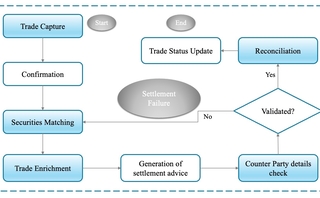MSCI’s multi-cloud strategy aims to provide a new window into investment data
The MSCI One platform already runs on Microsoft Azure, and MSCI is building a new investment data platform on Google Cloud to utilize the search giant's AI and NLP capabilities.

On February 5, 1969, Boeing’s 747 airliner took its first flight. The model, dubbed the “Queen of the Skies,” was built in response to requests from airline Pan-Am for a bigger jet that could accommodate greater demand for air travel. The 747 had double the capacity of its predecessor, the 707, with four engines and two levels that gave the plane a signature hump-like feature at the front. A new era of larger commercial planes had begun.
That same year, Capital International (CI) created the first index for stock markets outside the US. Morgan Stanley would later buy the licensing rights to the CI indexes and their data in the 1980s, forming the Morgan Stanley Capital International (MSCI) indexes, which were the dominant tools used to gain insights into markets outside the US for several years before more providers entered the market.
There are clear parallels between the 747 and MSCI. Their stories began in the same year, and they’ve both evolved over time to meet customer demands. Variants of the 747 included stretched upper decks, upgraded glass cockpits, and more powerful engines. Meanwhile, MSCI—which Morgan Stanley divested in 2007—made several acquisitions and expanded to cover equities, fixed income, real estate, as well as ESG and climate analytics.
In 2023, the evolution continues. Boeing’s 747 era ended this year as the airplane manufacturer retired the model due to large operating costs and amid more demand for and interest in fuel-efficient models. The last 747 was rolled out of Boeing’s plant in Everett, Wash., on January 31.
This year also marks a major change for MSCI as the vendor seeks to increase efficiency, ramp up speed of innovation, and meet client needs. It’s found that in the cloud.
Tackling the front end
In 2018, Jigar Thakkar left Microsoft, where he had most recently served as corporate vice president, and joined MSCI as its CTO and head of engineering. Cloud, he says, was an immediate conversation topic when he joined. “From day one, we started having conversations about our infrastructure strategy,” he says.
MSCI is utilizing its existing datacenters but is also deploying cloud providers Microsoft Azure and Google Cloud. Instead of partnering with one cloud provider to innovate current offerings and build new systems, it’s using more than one based on what will work best for specific use cases. Thakkar refers to it as a “blend.”
Across capital markets, banks and exchanges have increasingly looked to the cloud as Nasdaq moves exchange technology onto AWS infrastructure, JP Morgan and Goldman Sachs explore bringing market data to the cloud, and Fidelity Investments’ asset management arm looks to sunset all its datacenters in favor of AWS. Just this month, data giant S&P Global announced it would expand on its current relationship with its primary cloud provider, AWS, and move data applications like Capital IQ to the cloud by 2025.
In 2020, MSCI and Microsoft announced a strategic alliance, reuniting Thakkar with familiar territory. A year later, MSCI announced Investment Solutions as a Service in collaboration with Microsoft. Using Microsoft cloud and AI tools, as well as MSCI datasets, the initiative aimed to bring customized investment tools to users. Four services were launched in 2021: ESG Solutions as a Service, Index Solutions as a Service, Data Management Solutions as a Service, and Investment Analytics Solutions as a Service.
Following that initial rollout of services were Developer Community and Data Explorer, which became available last spring. Data Explorer enables users to search and navigate MSCI data, while Developer Community offers a searchable directory of MSCI’s application programming interfaces (APIs).
These services are now available under one roof: MSCI One, launched in December, is a web-based open architecture platform built on Microsoft Azure, which allows users to access its portfolio of analytics, indexes, and solutions through a single point of access. “All of these things are baked into MSCI One, and all of the new experiences we are going to be developing will also be weaved into the platform,” Thakkar says. The platform was built with client ease of access in mind but also faster integration of use cases. “A new use case in climate or ESG can be infused into MSCI One at a faster pace,” he says.
Microsoft’s technology worked for these projects and was attractive to MSCI due to tools like Microsoft’s Power BI data visualization tool, from which users can export data into the format of their choice. “It’s something our clients are very familiar with, they find it easy to use, and they can format the data into what they want it to be,” Thakkar says.
Prior to MSCI One, users of MSCI services would have had separate logins for different MSCI services, and may have had limited licenses or entitlements to services, leaving them unable to browse the vendor’s full catalog of data. The single point of access now allows users to browse all offerings, including the ones they don’t have licenses for, allowing more discovery.
Innovating offline
Underpinning the catalog of indexes, analytics, and services on MSCI One is data. Take, for example, an ESG reading on a company. Each reading requires 4,000 data points, Thakkar says. Those 4,000 data points come from thousands of documents and PDFs, full of unstructured data. The scale needed to structure that information is massive.
To aid this data ingestion and acquisition that occurs offline in the back-end, MSCI will build an investment data platform on Google Cloud over the next year. The platform will utilize Google’s AI and natural-language processing (NLP) tools like Document AI and Vertex AI. It will also enable MSCI to target the expanding field of ESG and climate analytics, using Google’s geospatial analytics tools like Earth Engine and BigQuery Geospatial.
Google created Earth Engine about 10 years ago as “a planetary scale analytics platform for geospatial imagery and analytics processing,” for the scientific community, before making it commercially available to other industries, says Jeff Sternberg, technical director of sustainability in the office of the CTO at Google Cloud. Tools like this allow visual analytics of how climate change and extreme weather have changed the Earth’s surface over time.
Once all this data passes through the MSCI–Google platform, it will feed into the analytics and offerings under MSCI One, enabling a faster data acquisition process.
The data acquisition process itself has changed in recent years, Thakkar says. “One of the fundamental issues that has happened in the last five years is that the number of data providers and the need for new data has exponentially increased since 2018,” he says. “If you had to evaluate a couple of data providers a month, you could do it manually, talk to them, look at the data, do some queries, and it was fine.”
Now, Thakkar says, MSCI looks at dozens of providers a week, meaning the time to evaluate datasets must be quicker. From there, it must determine how to integrate the datasets into current product offerings and distribute them faster.
“For that, it’s not just about raw compute and storage needs, which you can have in your datacenters. It’s also about modern technology, which is a lot easier to integrate when you’re on the cloud.” he says.
Private clouds could prove useful centers but may not meet time requirements needed to distribute new data and could have limited access to the necessary tech integrations. Additionally, more and more of the data providers MSCI evaluates are already in the cloud.
“These data providers that are popping up, many of them are already in the cloud, and they are sending their data through Amazon or through Snowflake,” Thakkar says. “So it becomes much easier when you’re in the cloud and you are talking in the same currency.”
Google is seen as having the edge in AI among cloud providers. Philip Moyer, vice president of strategic industries at Google Cloud told WatersTechnology in 2021 that it was looking to apply its AI toolbox to corporate actions. The tools that MSCI is looking to integrate into its investment data platform include Document AI, which ingests and extracts information from documents like PDFs, and other tools like Vertex AI, which allow for machine-learning experimentation.
“There’s traditionally been different expertise in the different cloud shops, but they are now becoming much more similar,” says Virginie O’Shea, founder and CEO of London-based fintech research firm Firebrand Research. “Microsoft with the recent investment in AI is now going down that route, so it’s not going to be perceived as a specialism of Google’s for long. I don’t expect there to be much differentiation between cloud providers in the next couple of years.”
Last month on the tailwind of significant hype about OpenAI’s ChatGPT, Microsoft, which had a preexisting partnership with the AI laboratory, extended its investment and collaboration to further integrate AI into its tech stack. Google, for its part, released its chatbot competitor, BARD, last week. The AI race appears to be on.
MSCI declined to reveal when it expects the investment data platform to be finished, but Thakkar says engineers from both companies are currently in the process of creating the network layout, getting data set up, and building a security architecture.
Further reading
Only users who have a paid subscription or are part of a corporate subscription are able to print or copy content.
To access these options, along with all other subscription benefits, please contact info@waterstechnology.com or view our subscription options here: http://subscriptions.waterstechnology.com/subscribe
You are currently unable to print this content. Please contact info@waterstechnology.com to find out more.
You are currently unable to copy this content. Please contact info@waterstechnology.com to find out more.
Copyright Infopro Digital Limited. All rights reserved.
You may share this content using our article tools. Printing this content is for the sole use of the Authorised User (named subscriber), as outlined in our terms and conditions - https://www.infopro-insight.com/terms-conditions/insight-subscriptions/
If you would like to purchase additional rights please email info@waterstechnology.com
Copyright Infopro Digital Limited. All rights reserved.
You may share this content using our article tools. Copying this content is for the sole use of the Authorised User (named subscriber), as outlined in our terms and conditions - https://www.infopro-insight.com/terms-conditions/insight-subscriptions/
If you would like to purchase additional rights please email info@waterstechnology.com
More on Emerging Technologies
Quants look to language models to predict market impact
Oxford-Man Institute says LLM-type engine that ‘reads’ order-book messages could help improve execution
The IMD Wrap: Talkin’ ’bout my generation
As a Gen-Xer, Max tells GenAI to get off his lawn—after it's mowed it, watered it and trimmed the shrubs so he can sit back and enjoy it.
This Week: Delta Capita/SSimple, BNY Mellon, DTCC, Broadridge, and more
A summary of the latest financial technology news.
Waters Wavelength Podcast: The issue with corporate actions
Yogita Mehta from SIX joins to discuss the biggest challenges firms face when dealing with corporate actions.
JP Morgan pulls plug on deep learning model for FX algos
The bank has turned to less complex models that are easier to explain to clients.
LSEG-Microsoft products on track for 2024 release
The exchange’s to-do list includes embedding its data, analytics, and workflows in the Microsoft Teams and productivity suite.
Data catalog competition heats up as spending cools
Data catalogs represent a big step toward a shopping experience in the style of Amazon.com or iTunes for market data management and procurement. Here, we take a look at the key players in this space, old and new.
Harnessing generative AI to address security settlement challenges
A new paper from IBM researchers explores settlement challenges and looks at how generative AI can, among other things, identify the underlying cause of an issue and rectify the errors.








